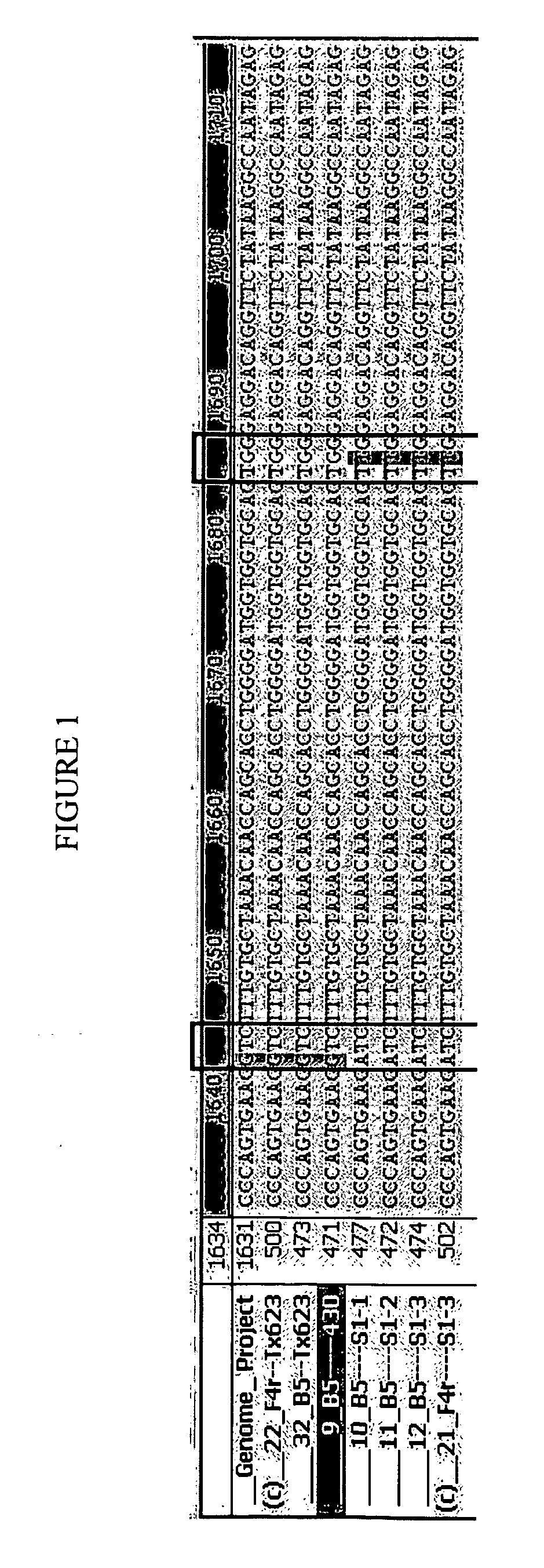Acetolactate Synthase Herbicide Resistant Sorghum
a technology of acetolactate and sorghum, which is applied in the direction of lyse, transferase, herbicide and algicide, etc., can solve the problems of reducing the growth of the desired crop plant, time and method of herbicide application are critical or in some cases unfavorable, and the use of these herbicides to control grassy weeds is almost impossibl
- Summary
- Abstract
- Description
- Claims
- Application Information
AI Technical Summary
Benefits of technology
Problems solved by technology
Method used
Image
Examples
example 1
Herbicide Resistance in Sorghum Genotype
[0082]Seeds of the wild sorghum genotype shown to exhibit an ALS resistant phenotype, designated “Tailwind”, and an herbicide susceptible sorghum genotype designated 90SN7 were planted in 12 liter pots in a greenhouse. Several of each type of plant were sprayed with either 1) Lightning Herbicide (a combination of Imazethapyr and Imazapyr) at the rate of 2.56 oz acre−1 (a 2× herbicide rate), 2) Steadfast® Herbicide (DuPont™; a combination of Nicosulfuron and Rimsulfuron) at a rate of 1.50 oz acre−1 (a 2× herbicide), or 3) a combination of Lightning Herbicide at 2.56 oz acre−1 rate and Steadfast® Herbicide at 1.50 oz acre−1 rate. For each treatment, the Tailwind plants showed essentially no damage after 12 days of herbicide application, while the 90SN7 plants were dead, demonstrating that Tailwind had cross-resistance to IMI (Lightening Herbicide) and SU (Steadfast® Herbicide) classes of ALS inhibiting herbicides.
example 2
Crosses of Tailwind with Elite Sorghum Parental Lines
[0083]Tailwind was crossed with various elite parents including Tx430 and Wheatland. F2 populations derived from crosses with these parents were evaluated by segregation analysis to determine the number of genes involved in the expression of tolerance. Plant populations were grown in a greenhouse and were sprayed with 1× and 3× rates of Accent® Herbicide (DuPont™; Nicosulfuron), Option® Herbicide (BayerCropScience; Foramsulfuron), and Steadfast® Herbicide. Population counts of live / dead plants allowed genetic analyses.
[0084]Segregation analysis indicated a single major, partially dominant gene in the population derived from Tx430 for each herbicide treatment. Similar analyses of populations derived from crosses with Wheatland indicated a single major, partially dominant gene as well as potentially two or three modifier genes that influenced the relative expression of the tolerance trait.
[0085]Plant breeding efforts were initiated ...
example 3
Gene Sequencing for ALS Resistance Gene
[0086]Gene sequencing efforts were initiated to determine if a target sight mutation existed for the herbicide tolerance phenotype. A sequence search performed using the National Institute of Health's Basic Local Alignment Search Tool (BLAST) in The Institute for Genomic Research (TIGR) Plant Transcript Assemblies database identified a Transcript Assembly representing a sorghum ALS gene (TA3960—4558; SEQ ID NO: 1). Amplification primers for polymerase chain reaction (PCR) were designed, F4r-CACATCACCCTTGTACCAGCTC (SEQ ID NO: 3) and B5-GATTGTGCACATTGATATTGATCC (SEQ ID NO: 4), to amplify regions of the sorghum gene analogous to regions of the Arabidopsis thaliana AHAS gene thought to influence the expression of ALS-herbicide tolerance (A. thaliana: Ala122, Pro197, Ala205, Trp574, and Ser653; Tan et al., 2005).
[0087]Polymerase chain reaction amplification primers were successfully used to amplify the region of the gene in herbicide resistant (S1-1...
PUM
| Property | Measurement | Unit |
|---|---|---|
| Electrical resistance | aaaaa | aaaaa |
Abstract
Description
Claims
Application Information
 Login to View More
Login to View More - R&D
- Intellectual Property
- Life Sciences
- Materials
- Tech Scout
- Unparalleled Data Quality
- Higher Quality Content
- 60% Fewer Hallucinations
Browse by: Latest US Patents, China's latest patents, Technical Efficacy Thesaurus, Application Domain, Technology Topic, Popular Technical Reports.
© 2025 PatSnap. All rights reserved.Legal|Privacy policy|Modern Slavery Act Transparency Statement|Sitemap|About US| Contact US: help@patsnap.com

